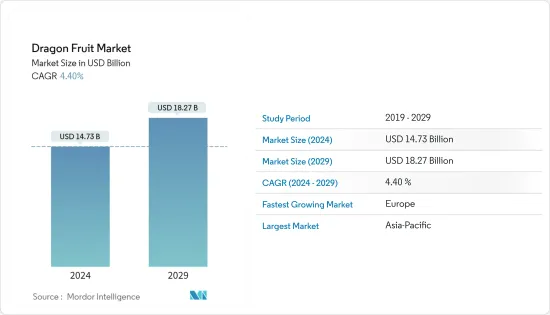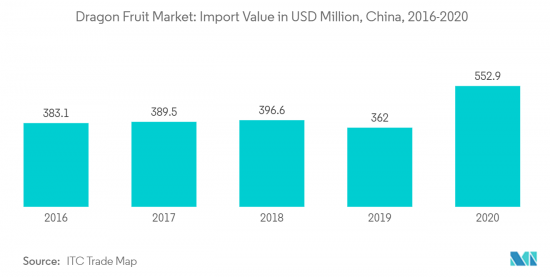 |
市場調査レポート
商品コード
1405683
ドラゴンフルーツ:市場シェア分析、産業動向・統計、成長予測、2024年~2029年Dragon Fruit - Market Share Analysis, Industry Trends & Statistics, Growth Forecasts 2024 - 2029 |
||||||
● お客様のご希望に応じて、既存データの加工や未掲載情報(例:国別セグメント)の追加などの対応が可能です。 詳細はお問い合わせください。
| ドラゴンフルーツ:市場シェア分析、産業動向・統計、成長予測、2024年~2029年 |
|
出版日: 2024年01月04日
発行: Mordor Intelligence
ページ情報: 英文 120 Pages
納期: 2~3営業日
|
- 全表示
- 概要
- 目次
ドラゴンフルーツ市場規模は2024年に147億3,000万米ドルと推定され、2029年には182億7,000万米ドルに達し、予測期間中(2024-2029年)のCAGRは4.40%で成長すると予測されています。

人々の健康と医療サービスへの深刻な影響に加え、COVID-19パンデミックは世界のドラゴンフルーツ市場にも大きな影響を与えています。需要面では、消費者の多くが賞味期限の長い健康的な商品に注目しているスーパーマーケットでの需要の低さが観察されたため、中国など多くのアジア諸国では果物の需要が低いままでした。さらに、COVID-19の大流行時にレストランが閉鎖されたため、ドラゴンフルーツの市場需要が急激に減少しました。仲介業者は市場に出回らない状況を恐れ、産地での買い付け量を減らしました。このため、多くの国で需給ギャップが拡大しました。
ドラゴンフルーツ市場は、新鮮なドラゴンフルーツへの需要の増加により、堅調な伸びを示しています。また、エキゾチックなトロピカルフルーツがもたらす様々な健康特典や、特に発展途上国における消費者の可処分所得の全体的な増加により、近年その需要は増加傾向にあります。欧州では、ドラゴンフルーツは比較的新しく、あまり宣伝されていないが、それでも市場は非常に有望で、より多くの消費者を引き付けています。これらがドラゴンフルーツ市場の成長を牽引している主な要因です。
特に米国では、健康志向の消費者がドラゴンフルーツを求めるようになっています。ドラゴンフルーツは米国では一年中入手可能ですが、いくつかの異なる国からも輸入されています。ドラゴンフルーツは特産品とされているため、米国におけるドラゴンフルーツのMRL(最大残留基準値)法は、リンゴやチェリーのような伝統的な製品とは大きく異なっています。米国に供給するために果実に使用できる化学物質は13種類に限られています。
アジア太平洋はドラゴンフルーツ市場を生産、消費の両面で支配しています。ドラゴンフルーツはベトナムの主要な輸出果実の一つです。ドラゴンフルーツの国際貿易は、主に南東アジアや中米などの主要輸出国を中心に展開されており、ドラゴンフルーツの国際貿易全体の中で最大のシェアを占めています。
ドラゴンフルーツの市場動向
中国におけるドラゴンフルーツ需要の拡大
ドラゴンフルーツは水分を多く含み、鉄分、マグネシウム、ビタミンB、リン、タンパク質、カルシウム、食物繊維の良い供給源です。この果物の食用種子も栄養価が高く、心血管障害のリスクを下げることが証明されています。ドラゴンフルーツは低カロリーで食物繊維が多く、ビタミンやミネラルも豊富に含まれています。前述のような利点に加え、中国人の食生活の変化も相まって、ドラゴンフルーツの需要は増加しており、輸入量も増加しています。
中国人はベトナム産のドラゴンフルーツのほとんどを消費しています。ベトナム工業貿易省によると、ベトナムで生産されるドラゴンフルーツの80.0%は中国に輸出され、中国市場で流通しているドラゴンフルーツの99.0%はベトナムから輸入されています。ベトナム産ドラゴンフルーツの中国市場での需要は、その生産量の多さと経済的重要性の高さから高いです。
2020年5月、中国税関総署はインドネシアからの生鮮ドラゴンフルーツ数品種を許可しました。輸入が許可されたドラゴンフルーツの品種には、果肉が紫色のドラゴンフルーツ、果肉が赤色のドラゴンフルーツ、果肉が白色のドラゴンフルーツが含まれます。これが中国のドラゴンフルーツ市場を牽引している要因のひとつです。

アジア太平洋が市場を独占
アジア太平洋ではベトナム、中国、インドネシアが最大のドラゴンフルーツ生産国です。ベトナムだけで世界のドラゴンフルーツ生産量の50.0%以上を占めており、生産量の大半は国内消費用ではなく輸出用です。ドラゴンフルーツは高価値作物に分類され、ベトナムの果実産業は競争優位にあります。ベトナムにおけるドラゴンフルーツの総生産面積は2019年で約55,000.0ヘクタールで、白果肉品種が生産量の95.0%以上を占め、次いで赤果肉品種が4.5%となっています。ドラゴンフルーツは主にビントゥアン省、ロンアン省、ティエンザン省で栽培されており、年間48,000.0ヘクタール以上が生産に充てられています。しかし、近年ベトナムのドラゴンフルーツ生産は、気候変動の影響や病気の発生など、多くの困難に直面しています。
アジアでは、ベトナムは中国市場への主要な供給国であるが、ASEANや香港などの他の市場では、台湾、タイ、マレーシアなどの競合が激化しています。さらに、アジアは生産量をリードしているだけでなく、最大のドラゴンフルーツ消費市場としても、特に中国人コミュニティの間で注目されています。中国はアジア最大のドラゴンフルーツ消費国であり、現在世界最大の消費国でもあります。
ドラゴンフルーツ産業概要
その他の特典
- エクセル形式の市場予測(ME)シート
- 3ヶ月間のアナリストサポート
目次
第1章 イントロダクション
- 調査の前提条件と市場定義
- 調査範囲
第2章 調査手法
第3章 エグゼクティブサマリー
第4章 市場力学
- 市場概要
- 市場促進要因
- 市場抑制要因
- バリューチェーン/サプライチェーン分析
第5章 市場セグメンテーション
- 地域(生産分析、数量・金額別消費分析、数量・金額別輸入市場分析、数量・金額別輸出市場分析、価格動向分析)
- 北米
- 米国
- カナダ
- メキシコ
- 欧州
- ドイツ
- 英国
- フランス
- オランダ
- アジア太平洋
- 中国
- ベトナム
- カンボジア
- インド
- タイ
- インドネシア
- 南米
- ブラジル
- コロンビア
- アルゼンチン
- 中東・アフリカ
- 南アフリカ
- イスラエル
- エジプト
- 北米
第6章 市場機会と今後の動向
第7章 COVID-19が市場に与える影響

The Dragon Fruit Market size is estimated at USD 14.73 billion in 2024, and is expected to reach USD 18.27 billion by 2029, growing at a CAGR of 4.40% during the forecast period (2024-2029).
In addition to the serious implications on people's health and healthcare services, the COVID-19 pandemic has had a significant impact on the global dragon fruit market as well. In terms of demand, low demand was observed in supermarkets where consumers are mostly focused on healthy products with a long shelf life, and hence, demand for fruits remained low in many Asian countries, such as China. Further, as the restaurants were closed during the COVID-19 pandemic, the market demand for dragon fruit suddenly dropped. Intermediaries were afraid of unmarketable conditions, so they reduced their purchase volume in production areas. This widened the demand supply gap in many countries.
The dragon fruit market is growing at a robust rate, owing to the increasing demand for fresh dragon fruit. Additionally, the demand for exotic tropical fruit is on the rise in recent years due to various health benefits that they offer and an overall increase in disposable income of the consumers, especially in developing nations. In Europe, although the dragon fruit is relatively new and is not widely advertised, still the market is very promising and attracting more and more consumers. These are the major factors that are driving the market growth of dragon fruits.
Health-conscious consumers are increasingly demanding dragon fruit, especially in the United States. Dragon fruit is available in the United States year-round, however, is also imported from a few different countries. As the dragon fruit is considered a specialty product, the MRL (Maximum Residue Level) laws for dragon fruit in the United States are very different compared to traditional products like apples or cherries. Only about 13 chemicals can be used on the fruit to supply to the United States.
Asia-Pacific dominates the dragon fruit market both in terms of production as well as consumption. Dragon fruit is one of the prominent export fruit of Vietnam. The international trade in dragon fruit mainly revolves around major exporters like countries in South East Asia and Central America which represents the maximum share of the entire international trade of dragon fruits.
Dragon Fruit Market Trends
Growing Demand for Dragon Fruit in China
Dragon fruit has high water content and is a good source of iron, magnesium, vitamin B, phosphorus, protein, calcium, and fiber. The fruit's edible seeds are also nutritious and have been proved to lower the risk of cardiovascular disorders. Dragon fruit is a low-calorie fruit that is high in fiber and contains a good amount of vitamins and minerals. Owing to the aforementioned benefits, coupled with the changing diet pattern among the Chinese population, the demand for dragon fruit is increasing, thereby, escalating the imports.
The Chinese people consume most of the whole dragon fruit produced from Vietnam. According to the Ministry of Industry and Trade of Vietnam, 80.0% of the dragon fruits produced in Vietnam are exported to China, while 99.0% of dragon fruits in the Chinese market are imported from Vietnam. The demand for the Vietnamese dragon fruit is high in the Chinese market mainly due to its sizable production and high economic importance.
In May 2020, China's General Administration of Customs permitted several varieties of fresh dragon fruit from Indonesia. The dragon fruit varieties that are allowed for import include purple-fleshed dragon fruit, red-fleshed dragon fruit and white-fleshed dragon fruit. This is one of the factors that is driving the market for dragon fruit in China.

Asia-Pacific Dominates the Market
In the Asia Pacific, Vietnam, China and Indonesia are the largest producers of dragon fruit. Vietnam alone contributed more than 50.0% to global dragon fruit production and the majority of the fruit production is meant for exports rather than domestic consumption. It is categorized as a high-value crop, and the local fruit industry in Vietnam has a competitive advantage. In Vietnam, the total area under the production of dragon fruit is approximately 55,000.0 hectares in 2019 with the white flesh variety accounting for more than 95.0% of production, followed by the red flesh variety at 4.5%. Dragon fruit is mainly grown in Binh Thuan, Long An, and Tien Giang provinces with more than 48,000.0 ha being devoted to its production, annually. However, recently dragon fruit production in Vietnam is facing many difficulties, including the impact of climate change and disease emergence.
In Asia, Vietnam is a leading supplier to the Chinese market, but other markets such as ASEAN and Hong Kong have been increasingly competitive from countries such as Taiwan, Thailand, and Malaysia. Additionally, Asia is not only leading the production but also as the largest dragon fruit-consuming market, especially among the Chinese community. China is the largest consumer of dragon fruit in Asia and is also the largest in the world today.
Recently, Vietnam signed a free trade agreement with the European Union, known as the European Union-Vietnam Free Trade Agreement (EVFTA). This agreement allowed Vietnamese imports to almost trade tariff-free and enabled them to control red skin red pulp dragon fruit import prices in the region. Hence, the exports of red skin red pulp dragon fruits from Vietnam to the European Union is anticipated to grow at a faster rate during the forecast period.
Dragon Fruit Industry Overview
Additional Benefits:
- The market estimate (ME) sheet in Excel format
- 3 months of analyst support
TABLE OF CONTENTS
1 INTRODUCTION
- 1.1 Study Assumptions & Market Definition
- 1.2 Scope of the Study
2 RESEARCH METHODOLOGY
3 EXECUTIVE SUMMARY
4 MARKET DYNAMICS
- 4.1 Market Overview
- 4.2 Market Drivers
- 4.3 Market Restraints
- 4.4 Value Chain / Supply Chain Analysis
5 MARKET SEGMENTATION
- 5.1 Geography (Production Analysis, Consumption Analysis by Volume and Value, Import Market Analysis by Volume and Value, Export Market Analysis by Volume and Value, and Price Trend Analysis)
- 5.1.1 North America
- 5.1.1.1 United States
- 5.1.1.2 Canada
- 5.1.1.3 Mexico
- 5.1.2 Europe
- 5.1.2.1 Germany
- 5.1.2.2 UK
- 5.1.2.3 France
- 5.1.2.4 Netherlands
- 5.1.3 Asia Pacific
- 5.1.3.1 China
- 5.1.3.2 Vietnam
- 5.1.3.3 Cambodia
- 5.1.3.4 India
- 5.1.3.5 Thailand
- 5.1.3.6 Indonesia
- 5.1.4 South America
- 5.1.4.1 Brazil
- 5.1.4.2 Columbia
- 5.1.4.3 Argentina
- 5.1.5 Middle East and Africa
- 5.1.5.1 South Africa
- 5.1.5.2 Israel
- 5.1.5.3 Egypt
- 5.1.1 North America
